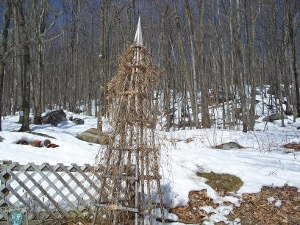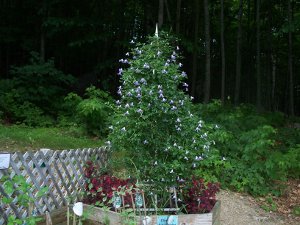Spring Cleaning: Pruning and Fertilizing Clematis
So spring is here, the snow is going fast, bulbs are poking up. And your precious clematis is nothing but a pile of dead brown sticks. Trust us - dismal as your clematis may look right now, it is fine. If your clematis is a Full Prune clematis, now is the time to prune it, while the stems are dry, brittle and easy to remove. Check out our Pruning Instructions for details.

The next step is feeding your clematis. Clematis are big plants. They grow fast. They make a lot of flowers. All that energy has to come from somewhere - and feeding your clematis properly will help supply the energy they need. Luckily, it's a simple process!
PLEASE NOTE: These directions are for plants that have spent a winter in the ground already. New clematis only need the fertilizer you provide when planting them according to our planting instructions.
The first step is to provide a dose of good quality compost first thing in the spring, as soon as the snow is gone, the ground is thawed and the plants have begun to grow just the teeniest bit. There are several companies that make high quality compost here in Maine so don't be tempted by the two-bucks-a-bag stuff some discounters offer - remember that you get what you pay for!
And how big is a "dose"? Wellllllllllll.......that depends a bit. We might give a big, fast growing mature clematis (like Betty Corning) a couple of shovelfuls. A small plant, such as Arabella, would only get one.
Later on, when the plants have begun to really grow, we give them rose fertilizer. We use RoseTone by Espoma for a number of reasons. First, it is a granular fertilizer and doesn't need to be dissolved in water or mixed with anything else. When you are fertilizing as many plants as we are, the convenience is a Big Deal! You can grab a bag and a measuring cup (we use 3/4 cup on big plants, less on smaller ones) and be finished in a jiffy. Fast and easy!
Another reason we use RoseTone is that it has the right nutrient balance for clematis (yes, they have about the same needs as roses) and also contains lots of trace minerals that contribute to a healthy plant. RoseTone is NOT technically an organic fertilizer, but it does have mostly organic ingredients.
RoseTone (along with some other Espoma products) also includes a number of beneficial microbes - bacteria and fungi, primarily. While this is a fairly new avenue of exploration for us, there seems to be a growing body of evidence that these microbes actually help suppress plant diseases! How cool is that?

In a perfect year, when we don't run out of time and nothing goes wrong (OK, stop laughing!), we give a dose of RoseTone in late spring and another again a month or so later. We NEVER fertilize after August 1st, as the plants need to be thinking about sleeping through the winter, not putting on more growth.
A BIG No-No in fertilizing: Never use the "blue fertilizers" on clematis. They have the wrong nutrient balance, don't provide the necessary trace elements and don't contain any beneficial microbes. Using the "blues" instead of compost and a quality rose fertilizer is like feeding your clematis vitamins instead of a balanced diet.
